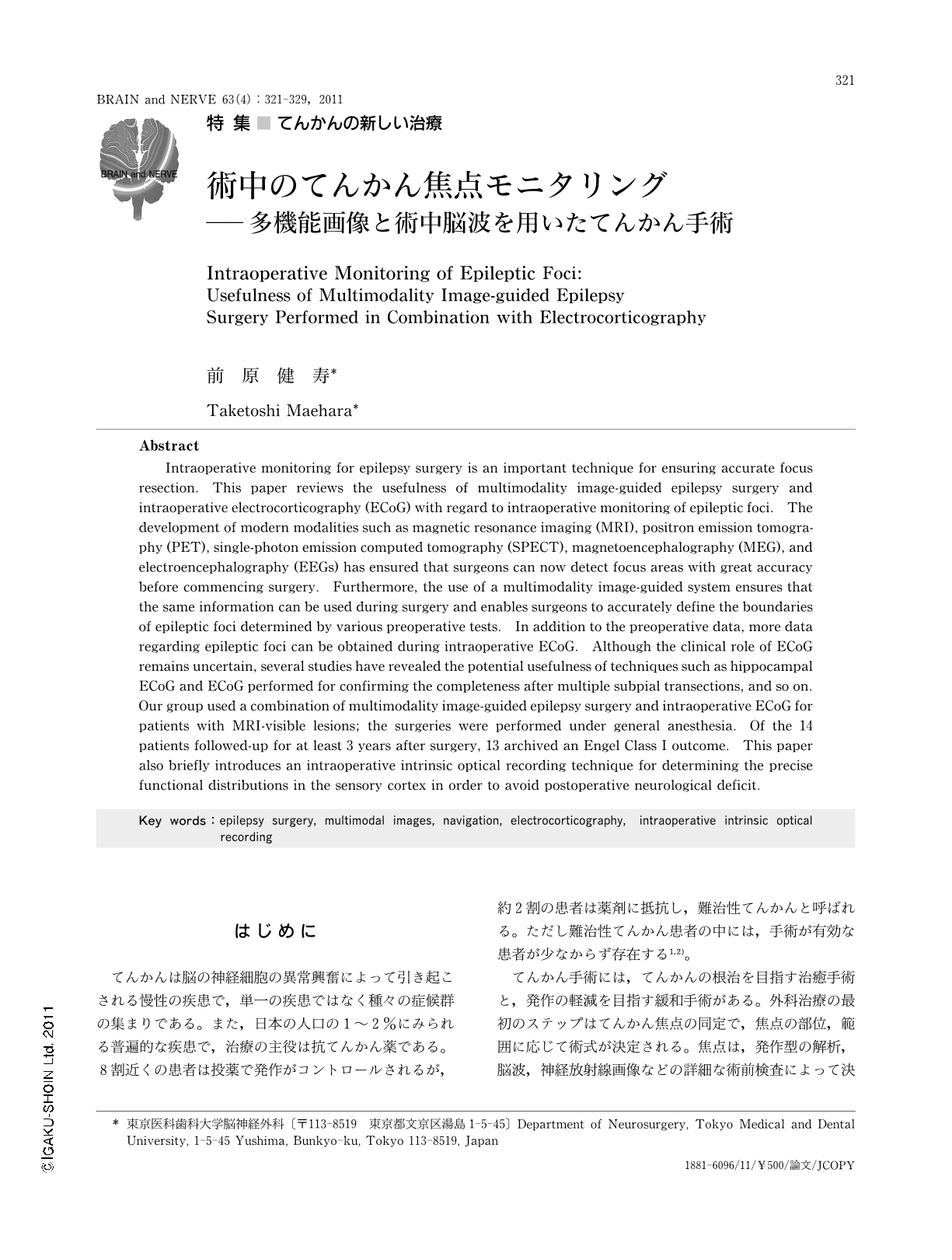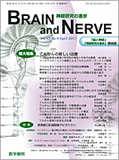Japanese
English
- 有料閲覧
- Abstract 文献概要
- 1ページ目 Look Inside
- 参考文献 Reference
はじめに
てんかんは脳の神経細胞の異常興奮によって引き起こされる慢性の疾患で,単一の疾患ではなく種々の症候群の集まりである。また,日本の人口の1~2%にみられる普遍的な疾患で,治療の主役は抗てんかん薬である。8割近くの患者は投薬で発作がコントロールされるが,約2割の患者は薬剤に抵抗し,難治性てんかんと呼ばれる。ただし難治性てんかん患者の中には,手術が有効な患者が少なからず存在する1,2)。
てんかん手術には,てんかんの根治を目指す治癒手術と,発作の軽減を目指す緩和手術がある。外科治療の最初のステップはてんかん焦点の同定で,焦点の部位,範囲に応じて術式が決定される。焦点は,発作型の解析,脳波,神経放射線画像などの詳細な術前検査によって決定されるが,局在が不明瞭な場合や検査結果が一致しない場合には,頭蓋内電極留置術を用いた侵襲的診断で焦点を決定するのが一般的である3)。
ただし,焦点という言葉で表現される領域は,検査の種類や判定者によって異なる領域を指す可能性がある。手術における焦点を,てんかん発作を起こしかつ切除で発作が止まる領域と考えると,この領域はLüdersらが提唱したてんかん原生領域(epileptogenic zone)にほかならない。しかし,実はてんかん原生領域とは単一の検査で決定することができない概念的な存在であり,さまざまな検査から類推される領域なのである1,4)。
てんかん手術では焦点を切除するため,術前診断の精密度が手術成績を左右する。それと同時に,重篤な合併症を起こさない安全な手術が必須であり,そのためには機能検査による運動感覚野や言語野の同定も必要となる。安全で精密な焦点切除術を行うためには,術前検査結果をいかに正確に術中に投影して,予定通りの切除を行えるかが最も重要である。術中には限られた検査を限られた時間で行わなければならず,したがって術中検査は術前焦点診断の正確さの確認や,焦点切除の精密性の検証という意味合いが妥当である。
本稿では,術中のより精密な焦点診断,手術のための第一歩として,てんかん焦点診断のためのさまざまな術前検査を概説する2,3)。そのうえで,これらの検査結果をナビゲーションシステムで術中に正確に反映し手術を行うmultimodality image-guided epilepsy surgeryの有用性を報告する2,3,5-7)。ナビゲーション手術では確実性と安全性の面から,頭位を厳密に固定する必要がある。局所麻酔下のモニタリングの適用は困難で,全身麻酔下で測定可能な皮質脳波が焦点診断のモニタリングとして併用される。そのため,術中皮質脳波の有用性と限界についての最近の報告も紹介する予定である8,9)。最後に全身麻酔下でも詳細な機能局在が同定できる方法である内因性光学イメージング法10,11)についても言及したい。
Abstract
Intraoperative monitoring for epilepsy surgery is an important technique for ensuring accurate focus resection. This paper reviews the usefulness of multimodality image-guided epilepsy surgery and intraoperative electrocorticography (ECoG) with regard to intraoperative monitoring of epileptic foci. The development of modern modalities such as magnetic resonance imaging (MRI),positron emission tomography (PET),single-photon emission computed tomography (SPECT),magnetoencephalography (MEG),and electroencephalography (EEGs) has ensured that surgeons can now detect focus areas with great accuracy before commencing surgery. Furthermore,the use of a multimodality image-guided system ensures that the same information can be used during surgery and enables surgeons to accurately define the boundaries of epileptic foci determined by various preoperative tests. In addition to the preoperative data,more data regarding epileptic foci can be obtained during intraoperative ECoG. Although the clinical role of ECoG remains uncertain,several studies have revealed the potential usefulness of techniques such as hippocampal ECoG and ECoG performed for confirming the completeness after multiple subpial transections,and so on. Our group used a combination of multimodality image-guided epilepsy surgery and intraoperative ECoG for patients with MRI-visible lesions; the surgeries were performed under general anesthesia. Of the 14 patients followed-up for at least 3 years after surgery,13 archived an Engel Class I outcome. This paper also briefly introduces an intraoperative intrinsic optical recording technique for determining the precise functional distributions in the sensory cortex in order to avoid postoperative neurological deficit.

Copyright © 2011, Igaku-Shoin Ltd. All rights reserved.


